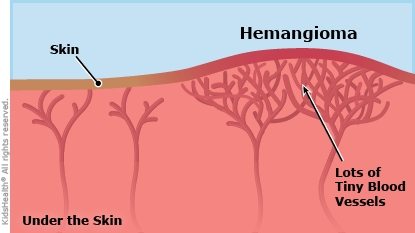Infantile Hemangioma: How to Care for Your Child
An infantile hemangioma (he-man-jee-OH-muh) is a type of birthmark. It is made up of tiny blood vessels and is usually red or purple. The appearance of hemangiomas can vary from person to person. They might be flat or bulging, small or large, bumpy or smooth. Most infantile hemangiomas are on the skin, but they also can be on the inside of the body. They usually go away on their own, but some might need treatment.


-
If the health care provider prescribed a skin cream or a medicine to take by mouth, use it as directed.
-
If the hemangioma bleeds:
-
With a clean cloth, put firm pressure on the hemangioma for 5 minutes.
-
Check to see if bleeding has stopped.
-
If bleeding hasn't stopped, put firm pressure on the hemangioma for 5 more minutes.
-
Check again to see if bleeding has stopped.
-
If the bleeding has not stopped, keep applying firm pressure and call the doctor.
-
If the hemangioma develops a sore, call your health care provider and:
-
Wash the area every day and keep it clean.
-
Put petroleum jelly on the hemangioma. If it is in the diaper area or covered by clothing, put a bandage over it. Be sure to change the bandage every day.
-
If the sore develops a crust, it may be helpful to put a clean washcloth moistened with cool water or sterile saline solution on the area for several minutes 2–3 times a day.
-
Most hemangiomas are painless, but they can hurt if a sore develops. If your child has pain, a medicine may help:
-
If your child has an ongoing medical problem (for example, a kidney, liver, or blood problem): Check with your health care provider before giving medicine.
-
For children younger than 3 months: Check with your health care provider before giving medicine.
-
For children 3–6 months: You may give acetaminophen (such as Tylenol® or a store brand).
-
For children older than 6 months: You may give acetaminophen (such as Tylenol® or a store brand) OR ibuprofen (such as Advil®, Motrin®, or a store brand).
-
Don't give aspirin to your child. Aspirin has been linked to a rare but serious illness called Reye syndrome.

-
The hemangioma grows very quickly.
-
The hemangioma develops a sore.
-
There is pain, warmth, redness, or swelling around the hemangioma.
-
The hemangioma bleeds and you cannot stop the bleeding by applying firm pressure on it for more than 10–15 minutes.
-
Your child looks pale.
-
The hemangioma doesn't start to shrink or fade when the doctor says it should.

What causes infantile hemangiomas and who gets them? Doctors do not fully understand how infantile hemangiomas form. They are more common in girls, in multiple births (such as twins or triplets), and in babies who are born prematurely (early).
Will my child's infantile hemangioma go away? Most infantile hemangiomas show up a few days or weeks after a baby is born. They can get bigger at first, but most start to go away when children are 6–18 months old. They slowly fade and flatten, and most will be gone (or almost gone) by the time a child is 5 years old. Sometimes a scar or other change in the skin can remain.
Does my child need any testing for the hemangioma? Often, no testing is needed. If a baby has many hemangiomas on the skin, though, a health care provider might order an ultrasound or an MRI (magnetic resonance imaging) test to see if any hemangiomas are inside the body.
When does a hemangioma need treatment? The health care provider may recommend medicine, surgery, or other treatment if a hemangioma:
-
becomes irritated or bleeds a lot
-
gets in the way of eating, breathing, hearing, or seeing
-
is very big or is upsetting to the parents or child